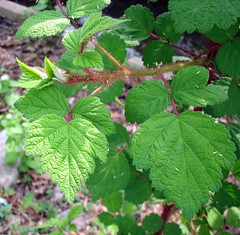
Wineberry
Originally uploaded by urtica.
Earlier this week I happened upon several patches of Wineberry plants (Rubus phoenicolasius) growing in an especially weedy strip of land between parking lot and highway in Hunt Valley, MD. It is easy to recognize this invader by the long, gland-tipped red hairs covering the stems. According to this fact sheet from the Plant Conservation Alliance, Wineberry was introduced introduced to the U.S. in the late 1800s for use in breeding new types of Rubus berries (raspberries, blackberries and the like). As with most thorny plants with juicy, edible fruit, its dispersal into natural areas was both inevitable (birds say "Yum!") and unwelcome (humans say "Ouch!").
Because you are probably wondering, yes, there is a recipe for wineberry wine.
1 comment:
Humans say "yum" too. I have a fine stand of wineberries on my property. June, when they ripen, is anticipated happily in my household. A few years ago we spent a delightful morning with Japanese friends picking and eating berries. In my mind that symbolically closed the circle for my little patch of these tasty invaders.
The lore in town is that indeed the local wineberries were introduced in the 1890's. There are stands scattered in the forests and hedgerows. Nowhere have the brambles taken over and the one on the edge of my property is the largest and most prolific that I have discovered.
Neighbors come by to pick them along with the mulberries and black raspberries that grow in the same hedgerow. But the wineberries are by far the favorite of everyone I know. Pairs of orioles have repeatedly nested above the wineberries and my guess is that they enjoy them too.
This has been a benign invasion and even beneficial from my point of view.
Post a Comment